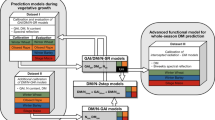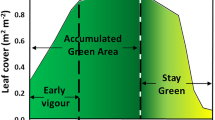Abstract
Three consecutive crops of malting barley grown during 2002–2004 on clay-loam on a Swedish farm (59°74’ N, 17°00’ E) were monitored for canopy reflectance at growth stages GS32 (second node detectable) and GS69 (anthesis complete), and the crops were sampled for above ground dry matter and nitrogen content. GPS-positioned unfertilised plots were established and used for soil sampling. At harvest, plots of 0.25 m2 were cut in both fertilised and unfertilised plots, and 24 m2 areas were also harvested from fertilised barley. The correlations between nine different vegetation indices (VIs) from each growth stage and yield and grain protein were tested. All indices were significantly correlated (at 5% level) with grain yield (GY), and protein when sampled at GS69 but only four when sampled at GS32. Three variables (the best-correlated vegetation index sampled at GS32; an index for accumulated elevated daily maximum temperatures for the grain filling period, and normalised apparent electrical conductivity (ECa) of the soil) were sufficient input in the final regressions. Using these three variables, it was possible to make either one multivariate (PLS) regression model or two linear multiple regression models for grain yield (GY) and grain protein, with correlation coefficients of 0.90 and 0.73 for yield and protein, respectively.




Similar content being viewed by others
References
Anderson A (1990) Fältmässig prövning av växtanalysmodell för kväve i höstvete och korn [Field evaluation of a plant analysis model in winter wheat and spring barley (in Swedish)]. In: Examensarbete, MSci thesis SLU, Inst. f. Markvetenskap, avd. f. Växtnäringslära, Uppsala, Sweden. http://lukas.slu.se, (accessed 15-Mar-2006)
Anon. (1993) Svensk Standard. SS 02 83 10:1993. Soil analysis-Extraction and determination of phosphorus, potassium, calcium, magnesium and sodium from soils with ammonium lactate/acetic acid solution. (In Swedish). Stand kom Sv, 7
Anon. (2002) Simca-P and Simca-P+ 10.0 user guide. Umetrics AB, Umeå, Sweden pp 366
Anon. (2004a) ESRI GIS and mapping software. ArcGIS 8.3 (www.esri.com), Redlands, CA, USA
Anon. (2004b) Gamma Design Software. GS+ geostatistic software (www.gammadesign.com), Plainwell, Michigan, USA
Austin RB, Morgan CL, Ford MA, Blackwell RD (1980) Contributions to grain yield from pre-anthesis assimilation in tall and dwarf barley phenotypes in two contrasting seasons. Annals Bot 45:309–319
Blackmore S (2000) The interpretation of trends from multiple yield maps. Comp Elect Agric 26:37–51
Boonchoo S, Fukai S, Hetherington SE (1998) Barley yield and grain protein concentration as affected by assimilate and nitrogen availability. Aust J Agric Res 49(4):695–706
Börjesson T, Söderström M (2003) Prediction of protein content in cereals using canopy reflectance. In: Stafford J, Werner A (eds) Precision agriculture. Proceedings of the 4th European conference on precision agriculture. Wageningen Academic Publishers, The Netherlands, pp 89–94
Broge NH, Leblanc E, (2000) Comparing prediction power and stability of broadband and hyperspectral vegetation indices for estimation of green leaf area index and canopy chlorophyll density. Remote Sensing Environ 76:156–172
Carlsson TN, Ripley DA (1997) On the relation between NDVI, fractional vegetation cover and leaf area index. Remote Sensing Environ 62:241–252
Delin S (2005) Site-specific nitrogen fertilization demand in relation to plant available soil nitrogen and water. Potential for prediction based on soil characteristics SLU. Doctoral thesis, Skara, Sweden, p 117
Ehsani R, Sullivan, M (2002) Soil Electrical Conductivity (EC) Sensors. Ohio state university. Extension factsheet. Food, Agricultural and Biological Engineering, AEX(565–02), 3. ohioline.osu.edu/aex-fact/0565.html (accessed 1-Mar-2006)
Eriksson L, Johansson E, Kettaneh-Wold N, Wold S (2001) PLS (Chapter 4). In: Multi- and Megavariate data analysis. Principles and applications. Umetrics Academy, Umeå, Sweden, pp 71–111
Fox J (2002) Linear least square regressions (Chapter 4.1). In: An R and S-plus companion to applied regression. SAGE Publications, Thousand Oaks, CA, USA, pp119–124
Gitelsen AA, Merzlyan MN (1996) Use of a green channel in remote sensing of global vegetation from EOS-MODIS. Remote Sensing Environ 58:289–298
Grashoff C, d’Antuono LF (1997) Effect of shading and nitrogen application on yield, grain size distribution and concentrations of nitrogen and water soluble carbohydrates in malting spring barley (Hordeum vulgare L.). Eur J Agron 6(3–4):275–293
Guyot G, Baret F, Major DJ (1988) High spectral resolution: determination of spectral shifts between the red and the near infrared. Int Arch Photogrammetry Remote Sensing 11:750–760
Haboudane D, Miller JR, Tremblay N, Zarco-Tejada PJ, Dextraze L (2002) Integrated narrow-band vegetation indices for prediction of crop chlorophyll content for application to precision agriculture. Remote Sensing Environ 81:416–426
Hansen PM, Jörgensen JR, Thomsen A (2002) Predicting grain yield and protein content in winter wheat and spring barley using repeated canopy reflectance measurments and partial least squares regression. J Agric Sci 139:307–318
Huhtapalo A (1982) Scandinavian principles for fertilizer placement, utilization of fertilizer-N nitrogen. In: Proceedings of the 9th Conference of the International Soil Tillage Research Organization, ISTRO. ISTRO, Osijek Yugoslavia, pp669–674
Huete AR (1988) A soil adjusted vegetation index (SAVI). Remote Sensing Environ 25:53–70
Jabro JD, Evans RG, Kim Y, Stevens BW, Iversen W (2005) Spatial variability of apparent electrical conductivity and cone index as measured with sensing technologies: assessment and comparison. In: ASABE technical library; www.asabe.org. American Society of Agricultural and Biological Engineers, St. Joseph, MI
Joernsgaard B, Halmoe S (2003) Intra-field variation over crops and years. Eur J Agron 19:23–33
Kim MS, Daughtry CST, Chappelle EW, McMurtrey JE, Walthall CL (1994) The use of high spectral resolution bands for estimating absorbed photosynthetically active radiation (APAR). In: Proceedings of the 6th Symposium on Physical Measurments and Signatures in Remote Sensing, January 17–21, 1994. ISPRS, Val D´Isere, France, pp299–306
Krafft A (2004) Fjärranalys av maltkorn - tio vegetationsindex förmåga att prediktera kväveskörd, avkastning och proteinhalt. [Remote sensing of malting barley - Ten vegetation indices ability to predict nitrogen yield, yield and protein content]. Examensarbete, MSci thesis SLU. Department of Ecology and crop production sciences, Uppsala, Sweden, p 51
Lark RM, Wheeler HC (2003) Experimental and analytical methods for studying within-field variation of crop responses to inputs. In: Stafford J, Werner A (eds) Precision agriculture. Proceedings of the 4th European conference on precision agriculture. Wageningen Academic Publishers, Wageningen, The Netherlands, pp 341–346
Palmer GH (2000) Malt performance is more related to inhomogeneity of protein and β-glucan breakdown than to standard malt analyses. J Inst Brewing 106(3):189–192
Porter JR (1993) AFRCWHEAT2: a model of the growth and development of wheat incorporating responses to water and nitrogen. Eur J Agron 2:64–77
R Developing Core Team (2005) A language and environment for statistical computing. URL http://www.R-project.org (accessed 1-Oct-2005), R Foundation for Statistical Computing, Vienna, Austria
Reusch S (1997) Entwicklung eines reflexionsoptischen Sensors zur Erfassung der Stickstoffversorgung landwirtschaftlicher Kulturpflanzen [Development of an optical reflectance sensor for determining the nitrogen supply to agricultural plants]. Dissertation, Christian-Albrechts-Universität, Kiel, Germany. (In German) p 155
Reusch S, Link A, Lammel J (2002) Tractor-mounted multispectral scanner for remote field investigation. In: Robert PC (eds) Proceedings of 6th International Conference on precision agriculture (CD). ASA/CSSA/SSSA, Madison, WI, USA, pp 1385–1393
Rondeaux G, Steven M, Baret F (1996) Optimization of soil-adjusted vegetation indices. Remote Sensing Enviro 55:95–107
Rouse JWJ, Haas RH, Deering DW, Schell JA, Harlan JC (1974) Monitoring the vernal advancement and retrogradation (green wave effect) of natural vegetation. In: NASA/GSFC Type III Final Report. NASA/GSFC, Greeenbelt, MD, USA, p 371.
Savin R, Nicolas ME (1996) Effects of short periods of drought and high temperature on grain growth an starch accumulation of two malting barley cultivars. Aust J Plant Phys 23:201–210
Schwab GJ, Pena-Yewtukhiw EM, Wendroth O, Murdock LW, Stombaugh T (2005) Wheat and yield population response to variable rate N fertilization strategies using active NDVI sensors. In: Stafford J (eds) Precision agriculture. proceedings of the 5th European conference on precision agriculture, Uppsala, Sweden. Wageningen Academic Publishers, The Netherlands, pp 235–242
Shanahan JF, Schepers JS, Francis DD, Varvel GE, Wilhelm WW, Tringe JM, Schlemmer MR, Major DJ (2001) Use of remote-sensing imagery to estimate corn grain yield. Agron J 93:583–589
Short NM (2006) The remote sensing tutorial. NASA home page, http://rst.gsfc.nasa.gov/Front/overview.html; (accessed 17-Feb-2006).
Stafford JV (1999) An investigation into the within-field spatial variability of grain quality. In: Stafford J (eds) Precision agriculture 1999. Proceedings of the 2nd European conference on precision agriculture. Sheffield Academic Press, Sheffield, UK, pp 353–361
Sudduth KA, Drummond ST, Kitchen NR (2001) Accuracy issues in electromagnetic induction sensing of soil electrical conductivity for precision agriculture. Comp Elect Agric 31:239–264
Tester RF, South JB, Morrison WR, Ellis RP (1991) The effects of ambient temperature during the grainfilling period on the composition and properties of starch from four barley genotypes. J Cereal Sci 13:113–127
Thiam A, Eastman JR (2001) Vegetation indices (Chapter 4). In: Eastman JR (eds) idrisi32 Release 2. Clark Labs, Worcester, MA, pp 89–101
Thylén L, Algerbo PA, Pettersson C (1999) Grain quality variations within fields of malting barley. In: Stafford J (eds) Precision agriculture 1999. Proceedings of the 2nd European conference on precision agriculture. Sheffield Academic Press Ltd, Sheffield, UK, pp 287–296
Tottman DR, Broad H (1987) The decimal code for the growth stages of cereals, with illustrations. Ann App Biol 110:441–454
Triboi E, Triboi-Blondel A-M (2002) Productivity and grain or seed composition: a new approach to an old problem - invited paper. Eur J Agron 16:163–186
Acknowledgements
We wish to thank Kristina Eek and Anders Anderson Yara Sweden, and the Yara N-Sensor team in Hanninghof Germany, for their help and support in extracting data from obscure log files. Thanks to Professor Robert Hay, who has helped us put this material into a bigger context and also helped a lot with our use of English.
This project has been possible due to economic support from Stiftelsen Svensk Växtnäringsforskning, Lantmännen and Precisionsodling Sverige (POS).
Author information
Authors and Affiliations
Corresponding author
Rights and permissions
About this article
Cite this article
Pettersson, CG., Söderström, M. & Eckersten, H. Canopy reflectance, thermal stress, and apparent soil electrical conductivity as predictors of within-field variability in grain yield and grain protein of malting barley. Precision Agric 7, 343–359 (2006). https://doi.org/10.1007/s11119-006-9019-4
Published:
Issue Date:
DOI: https://doi.org/10.1007/s11119-006-9019-4




